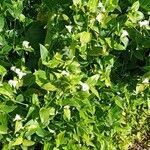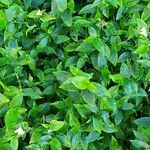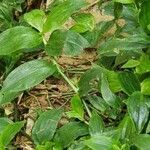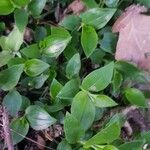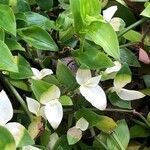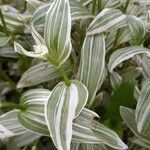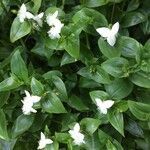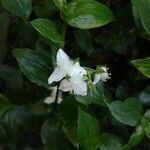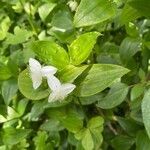Herbs, decumbent, rooting at nodes. Leaves 2-ranked; blade lanceolate-elliptic to ovate-lanceolate, 2.5--5 ´ 1--2 cm (distal leaf blades wider or narrower than sheaths when sheaths opened, flattened), margins ciliolate, apex acute, glabrous. Inflorescences terminal, becoming leaf-opposed, sometimes axillary from distalmost leaf axil, 1--2 cyme pairs per stem; bracts mostly foliaceous, occasionally reduced. Flowers distinctly pedicillate; pedicels 1--1.5 cm, glandular-pilose; sepals 5--7 mm, midrib pilose with eglandular hairs; petals distinct, white, not clawed, 8--9 mm; stamens free; filaments white, densely bearded with white hairs.
Perennial herb; stems leafy, decumbent. Leaves distichous, ovate-acuminate, sheath with short white hairs at mouth, 25-40 x 15-20 mm, usually with white and purple stripes, adaxial surface purple. Inflorescence a cyme. Flowers: petals ovate, white. Stamens 6; filaments bearded in lower half; anthers with obtriangular connective; locules spreading towards apex. Ovary 3-locular, oblong-globose, with 3 ovules in each locule; style terete or ± swollen in middle; stigma capitate. Flowering time Oct.
Trailing perennial with succulent stems, rooting readily at nodes, ascending above. Leaves 3-6 cm long, ovate-elliptic, acute, shining, very shortly petioled, leaf-and petiole-margins ciliate; sheaths 5-10 mm long, loosely clasping, hyaline, obviously ciliate. Flowers several in umbels with 2 unequal leaf-like bracts; pedicels slender, to 1.5 cm long; sepals green, c.7 mm long, ovate, hairy on keel; petals white delicate, c. 10 mm long, ovate to elliptic. Capsule not seen.
Perennial herb with decumbent, slender, leafy stems, rooting at nodes. Flowers actinomorphic. Inflorescence terminal. Petals ovate, ± 8 mm long. Leaves ovate-acuminate, abruptly narrowed into a short, broad, open, ciliate sheath. Weed. Flowers white.
A herb. It keeps growing from year to year. The leaves are 2-5 cm long by 0.7-2.3 cm wide. The base is unequal.
